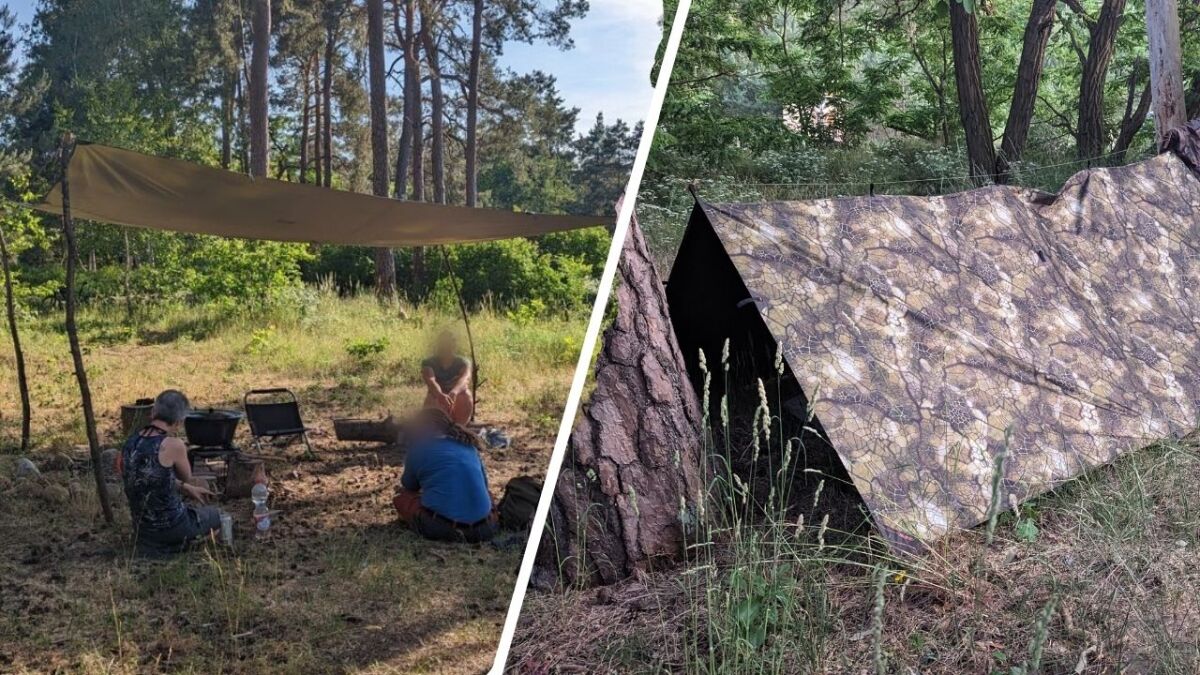
35 Tarp-Hacks that every outdoor enthusiast should know
👉 The key facts from this guide
- Versatile Uses: A tarp is an extremely versatile outdoor tool that can be used in a variety of situations. It's not just a simple rain or sun shelter, but can also serve as emergency shelter, fire protection, collection point for rainwater, or protection against insects.
- Valuable Addition for Outdoor Activities: Whether camping, hiking, or survival training, a tarp is a valuable addition to any outdoor equipment. It's lightweight, compact, and easy to transport, making it an ideal companion for outdoor adventures.
- Practical Application: A tarp can be set up in various ways depending on need and situation. It can be hung between two trees, spread out on the ground, or secured with ropes and stakes.
- Important Considerations: When using a tarp, it's important to choose the right material and size. Not all tarps are fully waterproof or UV-resistant, so the appropriate tarp should be selected depending on the intended use.
A tarp is a versatile and indispensable piece of equipment for anyone interested in survival or bushcraft adventures.
Although at first glance it may look like a simple tarp, you may have already noticed that a tarp can actually be extremely useful in a variety of situations.
For my part, I have already used tarps for many purposes and have decided to share my experiences and knowledge with you so that you can also benefit from them.
Therefore, in this article, we will explore together 99 different ways in which you can use your tarp for your next survival or bushcraft adventure.
1. Protection from Rain and Wind
One of the most obvious uses for a tarp is protection from rain and wind.
Whether you're spending a night under the stars or setting up camp, it's important that you and your gear stay dry so that you have a safe and comfortable environment.
The tarp can be set up in various ways to protect against rain and wind
A basic method is to hang the tarp between two trees or posts to create a roof that drains rainwater.
If you want to collect rainwater in a barrel or other containers, position them where the water flows down from the tarp. But more on that later.
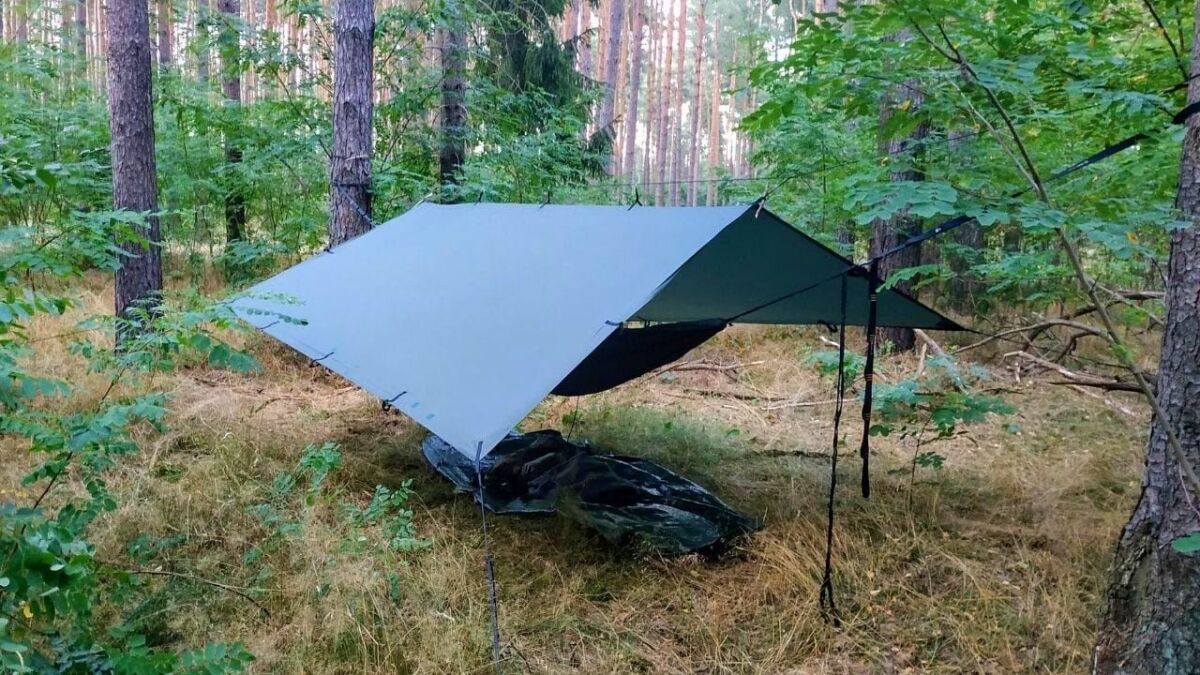
When it is windy, you should pay special attention to the position of the tarp. It is unfavorable if the wind gets directly under the makeshift roof and damages or even flips the tarp.
It is also possible to use the tarp as a side wall to protect you from sideways rain or wind
For this, you can either attach your provisional wall directly to the ground or hang it on a string or rope. Ideally, it should be securely fastened (with the best knots) and not blow around wildly, but that goes without saying.
Here are a few more hints:
- To effectively use the tarp as a rain shelter, it is important to pay attention to the appropriate size and shape.
- A tarp that is too small will not provide enough protection, while a tarp that is too large can be more difficult to set up and control.
- Rectangular tarps often offer more versatility than other shapes.
To complement this, I have created a detailed buying guide for tarps. Take a look at it so that you don't make a bad purchase.
With some practice and creativity, you can use almost any tarp to stay dry and protected in almost any situation.
2. Emergency accommodation for overnight stays
Another useful application for a tarp is the construction of an emergency shelter where you can spend the night.
This can be particularly helpful in emergencies where you need a place to stay quickly, or your tent may have been damaged or even lost.
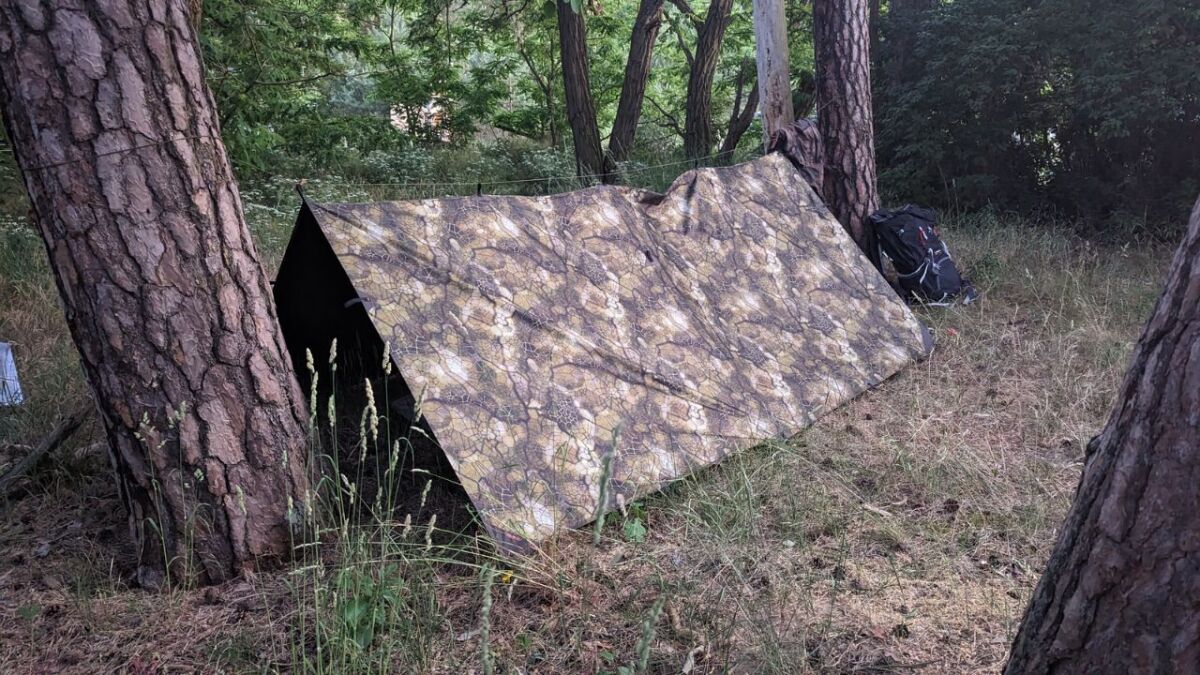
Here, too, it is advisable to hang the tarp between two trees to form a sloping roof.
Here, you should always make sure that the tarp is tightly stretched. This creates enough space underneath and prevents moisture and wetness from seeping through.
For additional protection, you can build sidewalls out of branches or twigs.
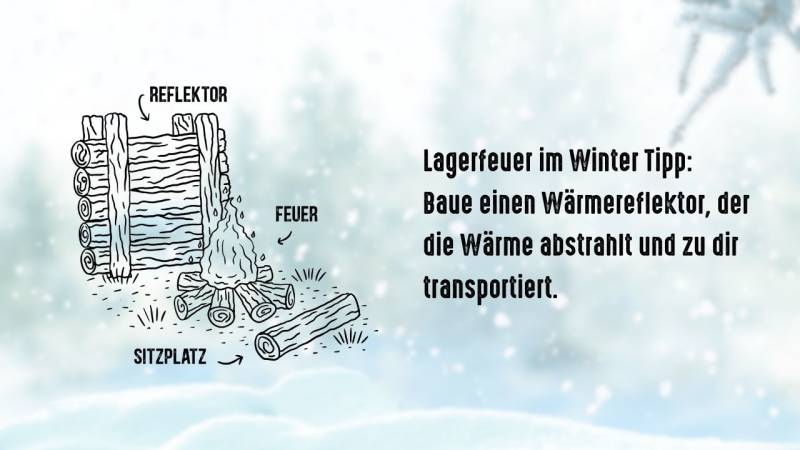
Alternatively, tent poles or trekking poles can also be used to set up your tarp and create a more spacious emergency shelter.
Use everything you can find around you in case of emergency, and that seems reasonable to you.
It is important to know that while a tarp gives you a roof over your head, it usually does not keep you warm.
Therefore, you should look for a dry and preferably relatively warm ground on which you can stay for a while. Ideally, you have a sleeping mat (here my best sleeping mats) on which you can sleep.
3. Sun Protection
In addition to protecting against rain and wind, your tarp also serves as effective sun protection.
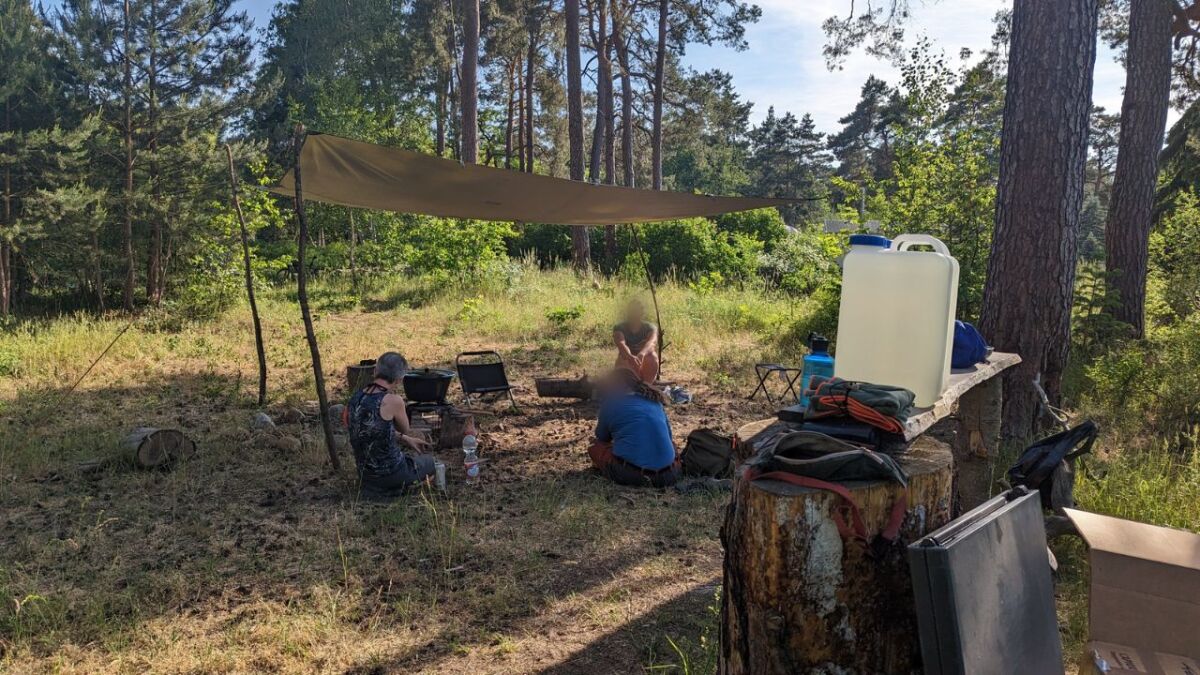
Especially in extreme temperatures and strong sunlight, it is important to protect yourself from the sun to avoid sunburn and heat exhaustion.
You can hang the tarp as a simple sunshade to create a shaded area.
Depending on the position of the sun, you can adjust it to protect yourself adequately. Check beforehand whether you should attach the tarp in a lateral position or directly above you.
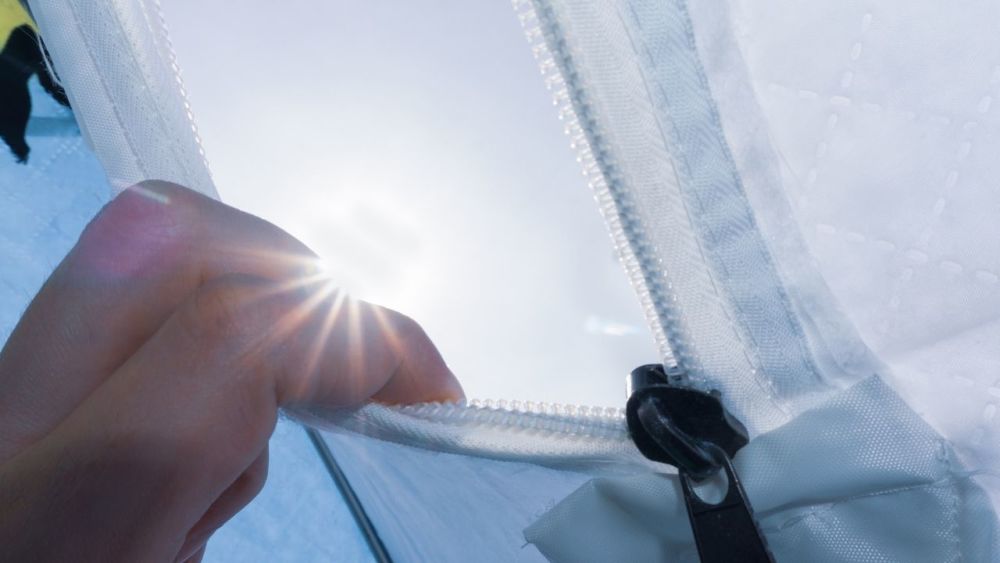
Another option is to use the tarp with other materials to create a larger and more effective shaded area.
For this, you can build the provisional sun protection on a frame made of wood, bamboo or other materials. The size of the shaded area varies depending on the construction and tarp.
However, you should always keep in mind that a tarp does not always provide sufficient protection against UV radiation.
Depending on the tarp, you may need to take additional measures for sun protection, such as applying sunscreen or wearing a sun hat (here's my guide to it) or sunglasses.
Also read
Survival in summer: Surviving extreme heat without air conditioning (+ tips for the desert) - It's hot where you are, there's a heat wave, and you don't have air conditioning? Find survival tips here for heat in the city, forest, and desert.
4. Fire Protection
In some situations, it may be necessary to protect your campfire from external influences to ensure that it does not go out - you can also use your tarp for this.
You can hang the tarp over the fire to protect it from rain or snow.
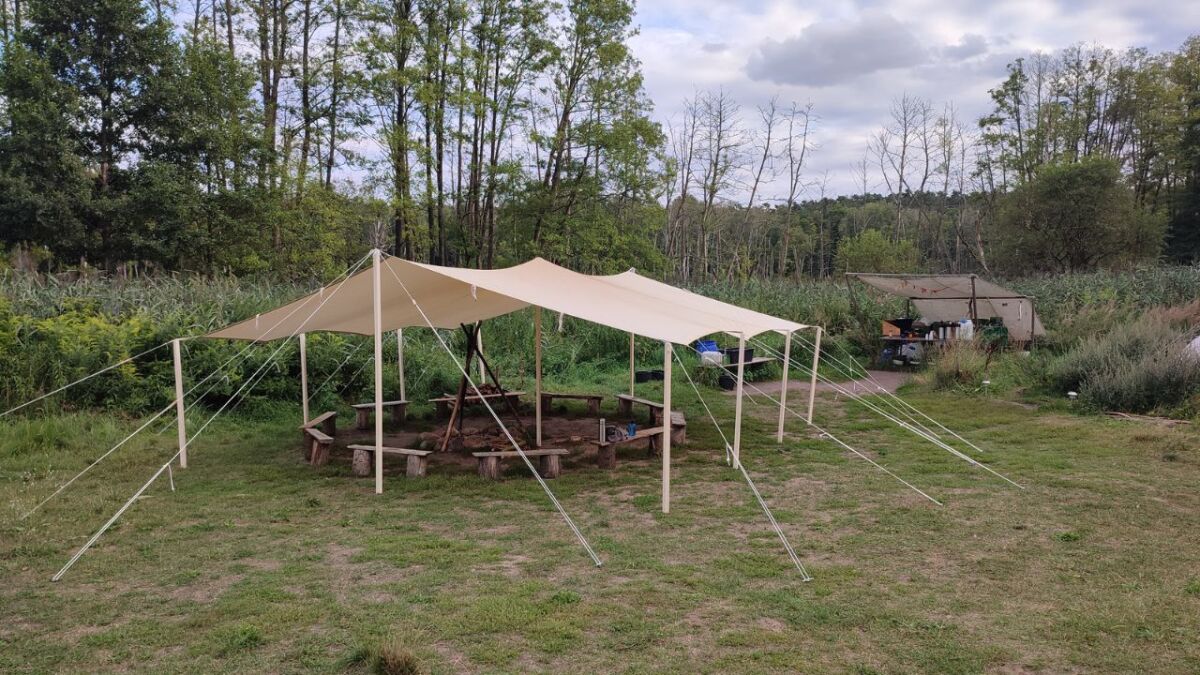
Some things are important:
- Your tarp should not be made of synthetic fibers, but of thick cotton.
- The tarp should be large enough.
- The tarp should be placed at a sufficient distance above the fire to avoid overheating and thus fire hazard. A suitable height is usually about 2–3 meters above the fire. However, this also depends based on the fire.
Alternatively, you can also use the tarp with a semi-closed tent to create a cozy campfire setup.
If you want to use the good piece as fire protection, you should definitely pay attention to the material of the tarp, especially its flammability.
For some tarps, materials are used that can quickly catch fire - such as nylon. This can be literally dangerous if you don't pay attention.
5. Collection point for rainwater
At the beginning of the article, I briefly mentioned that you can also use a tarp to collect rainwater in survival situations.
With little effort, you have a reliable source of water that you can use, for example, for washing.
To make your plan work, you can set up the tarp in a hollow or a slight depression - this way you can collect rainwater.
It is important to ensure that you stretch the tarp tightly and stably to allow for sufficient water accumulation. The collected water can then be transferred to clean containers and used afterward.
However, I would like to point out that you should not drink rainwater without further treatment - at least not until you have purified and cleaned it.
Untreated water can contain harmful bacteria or viruses that can lead to gastrointestinal diseases. Furthermore, rainwater can contain other pollutants from the air.
You can purify rainwater by boiling it, filtering it, or treating it with water purification tablets.
If you are keen to learn a little more about rainwater or treating drinking water, refer to these two articles on my blog:
- Find, collect, filter and make drinking water drinkable
- Is rainwater clean and drinkable? (Answer: mostly)
- 8 methods to boil water without a pot
6. Protection against insects
Who doesn't know it - you're out in the open, experiencing a survival or bushcraft adventure in glorious weather conditions?
Unfortunately, you have to deal with small pests that sting, pinch or bite you - we are, of course, talking about insects such as mosquitoes, beetles, ticks, or spiders.
A tarp can also help you here.

You can do the following:
- You can hang one or more tarps around your shelter to create a simple blockade.
- On the other hand, there are special tarps that are impregnated with insect repellent. Such models are also called "vector protection" in the German army - they are extremely effective against insect infestation and provide protection against mosquitoes and ticks.
However, keep in mind that a tarp alone usually does not provide sufficient protection against all types of insects.
Especially with mosquitoes or in typical tick-risk areas, it is advisable to take additional measures such as wearing long clothing and applying insect repellent.
And if nothing else helps, you'll probably have to wrap yourself completely in your tarp. 😛
7. Protection for equipment or supplies
As a rule, survival equipment is comparatively resilient.
However, it still makes sense to protect certain objects from moisture or dirt that are particularly susceptible to rust or minor damage from dirt. A tarp can also be useful for this purpose.
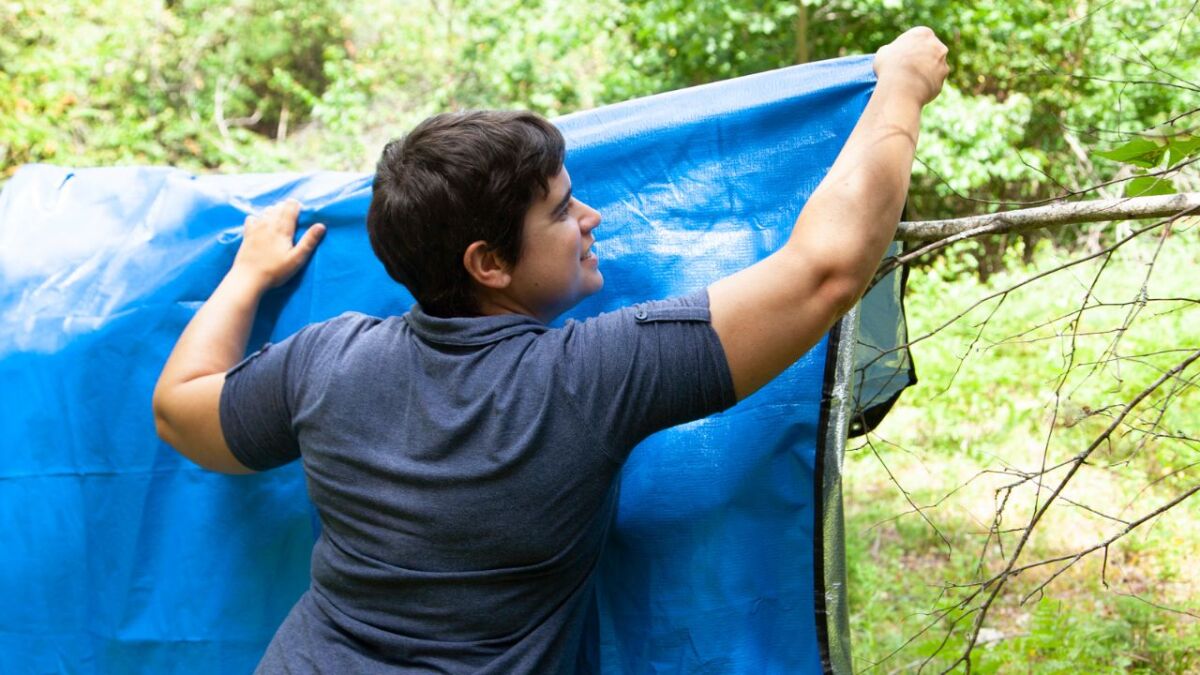
Are you currently on a hike and want to take a break? A tarp can serve as temporary protection for your equipment while you rest or eat.
Even if you are in your camp, your tarp can help protect your equipment or supplies from moisture, such as rain or snow. This applies to survival as well as cooking equipment or supplies alike.
Tarps are available in various sizes, so you can choose according to your needs and personal preferences. You can also combine multiple Tarps to cover larger items such as bicycles or camping equipment.
However, keep in mind that not every tarp is completely waterproof. While cotton tarps can provide some protection against rain and moisture, they will eventually become leaky during heavy rain and excessive moisture.
Tip: For very sensitive items that must be protected from moisture, it is better to pack them in waterproof containers or to get a 100% waterproof tarp.
8. Privacy and Screen Protection
We humans are beings who enjoy a little privacy in certain situations.
There are always moments when we prefer to be completely alone and undisturbed.
Sure, when camping or during a survival adventure, this can be difficult, but not impossible. You can also use the all-purpose tool praised in the article for this purpose.
With a few supports, you can set up your tarp as a wall or small border fence to separate areas and protect yourself from unwanted looks.
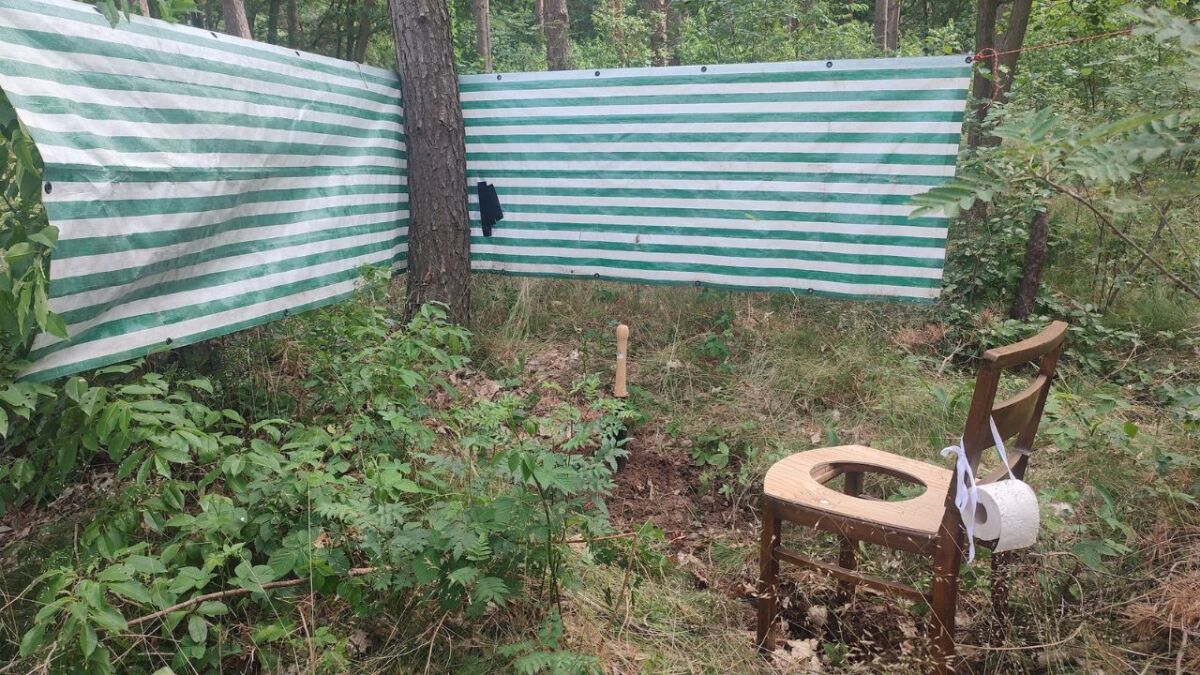
This can be particularly helpful if you are on a crowded campsite or camping in a busy area.
And yes, even in seminars and with large groups, you can use a tarp for the toilet (Read here how to go to the restroom in the woods).
Additionally, you can darken your sleeping area a bit thanks to a tarp or use it as an additional privacy screen.
However, it is important to note that the construction of a privacy screen or "private zone" is not always allowed everywhere, this may apply to public areas, among other things.
Therefore, you should always inform yourself about local laws and regulations before setting up a privacy screen in the middle of busy places.
9. Windbreaker when cooking or making a fire
When it comes to any activities in the wilderness that involve fire or heat, a particularly important factor usually comes into play - the wind.
The wind can in a way help you to start a fire - or entirely ruin the experience for you, leaving you more frustrated than ever before.
So that the wind doesn't ruin your cooking or fire making plans and spoil your mood, use your tarp as a classic windbreaker.
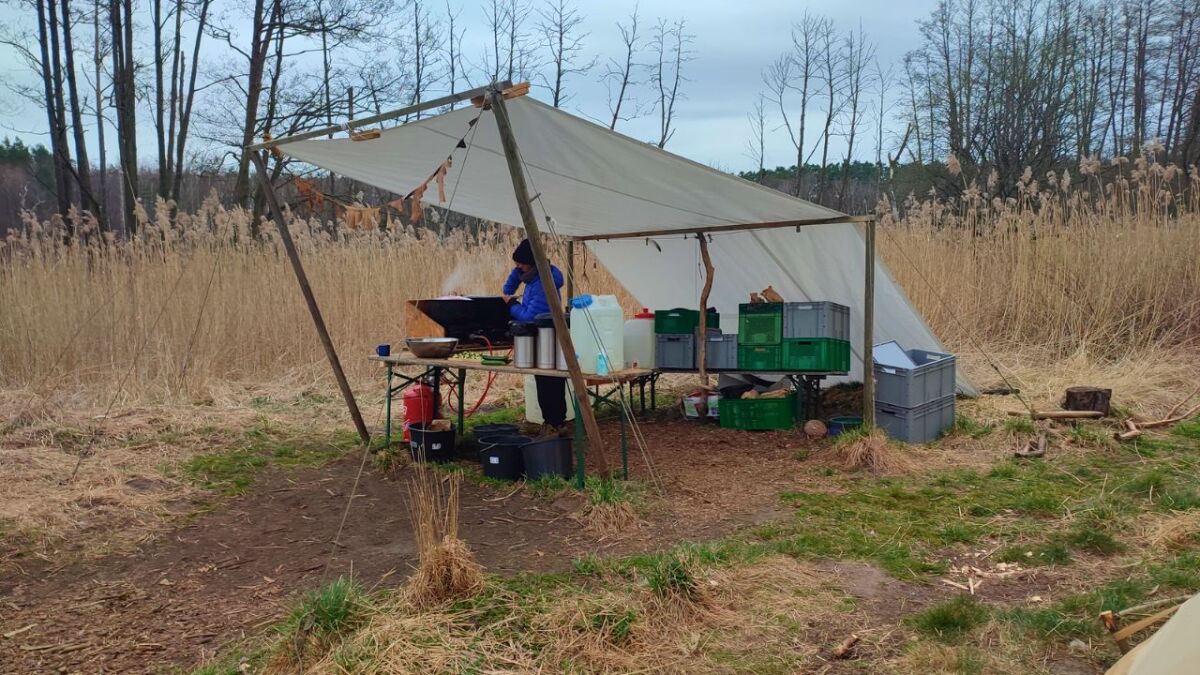
By setting up or hanging the tarp as a windbreaker around your fire or cooking area, you can greatly minimize the influence of the wind. This helps prevent the fire from being extinguished and your cooking equipment from being tossed around in strong winds.
Another advantage of the great tarp windbreaker is that it gives you more control over the fire and smoke. By keeping the wind away from your fire or cooking area, you can direct the fire and smoke in a certain direction and prevent smoke from getting into your tent or other areas.
As mentioned before, it is also important here that you do not place your tarp too close to the fire and handle it safely. After all, you would rather not start another uncontrolled fire.
I recommend using a thick cotton tarp for this method. Do not use a thin nylon tarp, as it will only end up with holes.
10. Shade for pets or livestock
Okay, you may wonder about this point now. However, you can believe me when I say that many animals need a protected and shady place on hot summer days.
By stretching the tarp over the area where your animals are located (whatever you currently own), you can provide them with a cool and shady place.
This is particularly useful for pets such as dogs and cats.
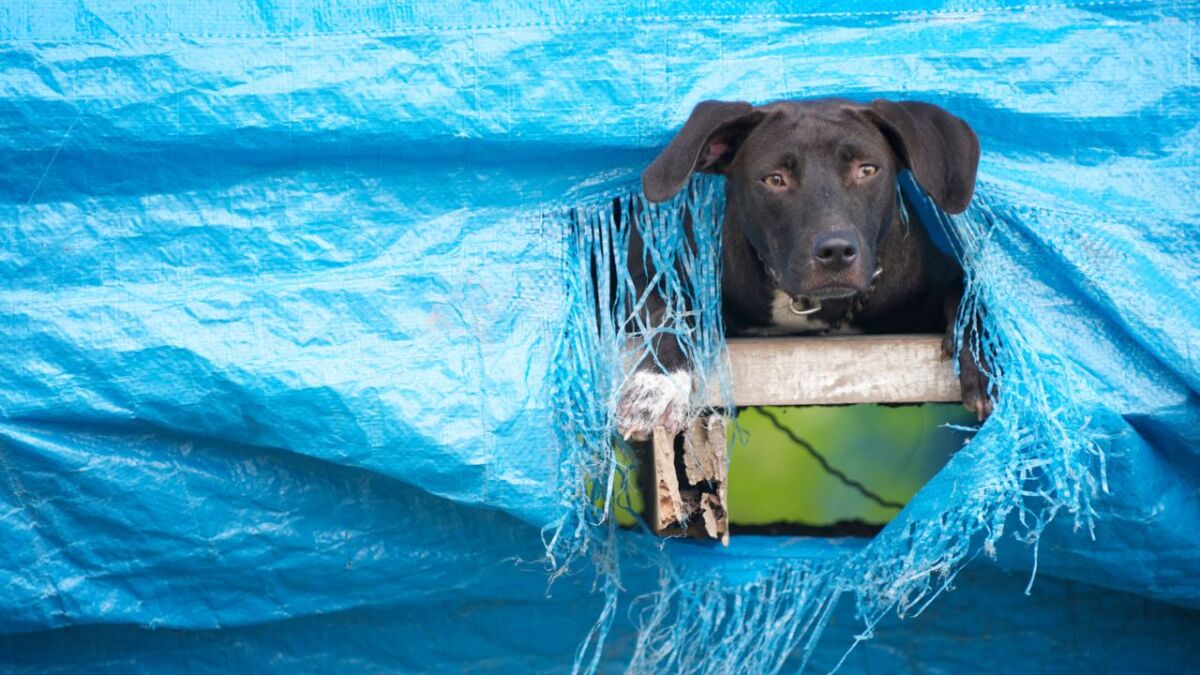
But even as a self-sufficient person, the tarp can help you - for your livestock such as horses, cows, rabbits, or chickens. The size and number of tarps naturally varies with the size and number of animals.
Another advantage of the temporary tarp shade provider is that it gives you more control over the location of the animals. You can set up the tarp to assign a specific area to your animals, or move it to protect them from the sun while they move around the pasture, for example.
However, it is necessary to note that when setting up the tarp for the animals, you should always act with safety in mind. Make sure that the tarp is stable and secure so that it does not pose a danger to the animals.
Also read
Bushcraft with Dog: Equipment, Leash Obligation and Hunter - Bushcraft with Dog: Learn the basics you need to consider: provisions, equipment, safety, leash obligation, hunter and how to handle your dog
11. A tarp as a groundsheet
And here we have one of my favorite tarp hacks: Use your tarp as a groundsheet!
The ground at the perfect camping spot is often anything but perfect - damp, rocky, uneven. But your faithful companion, the tarp, can provide a remedy here.
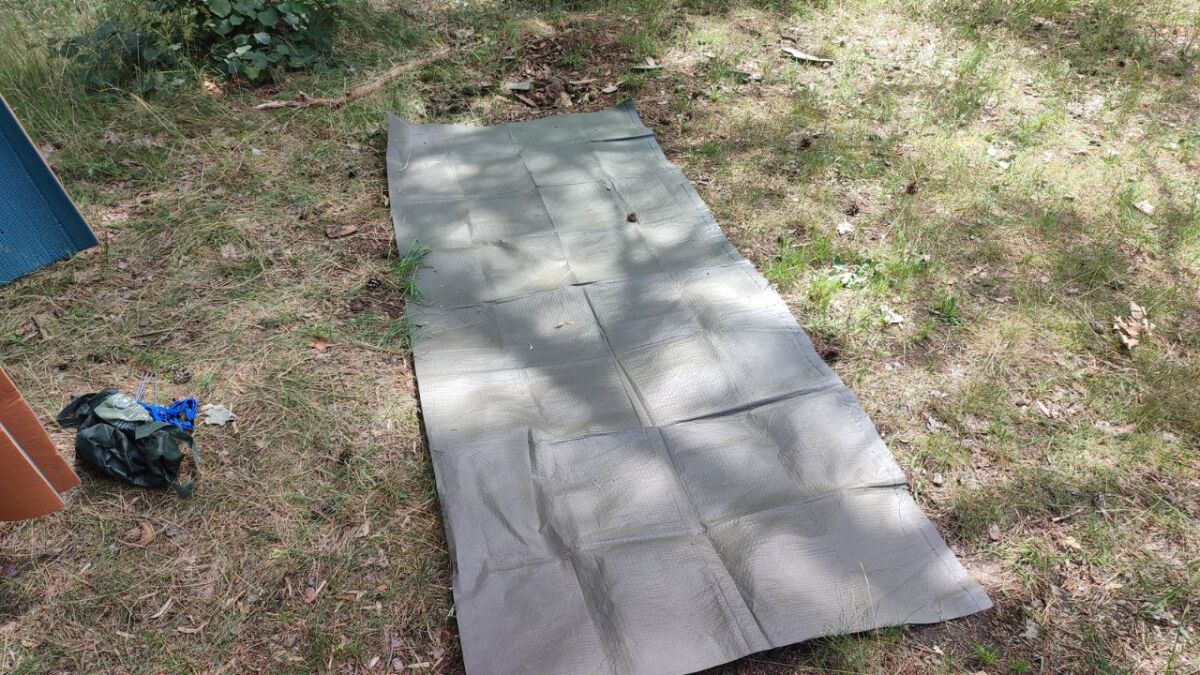
Simply spread it out before setting up your tent, and you'll have a waterproof barrier between you and the uncomfortable ground.
It protects you from moisture and provides a clean, even surface for your tent.
Adaptation is the key here: adjust the size of your tarp as needed to fit the size of your tent.
If it's big enough, you can even set up a small area for your equipment to protect it from the elements. So, your tarp is much more than just a rain cover - it's your reliable ground protector.
12. Portable Hammock
Did you know that your tarp can do more than just provide protection from the weather? It can also be turned into a portable hammock!
- Grab your tarp and two sturdy trees.
- Fold the tarp in half, tie it securely to the trees with a strong rope - and voilà!
- Your homemade hammock is ready.
Step in carefully and test if it carries your weight. A brilliant, lightweight, and practical hack for your next adventure.
13. Improvised Carrying
Did you know that your tarp can also function as an improvised carrier?
Exactly, it is a real all-rounder and a potential lifesaver. Here's what you need to do to improvise this carrier:
- Spread out your tarp flat on the ground.
- Find two sturdy branches that are longer than your tarp.
- Wrap each side of the tarp around the branch. Tie your tarp together at the bottom. Make sure it is tight and secure. A sturdy band or rope can be helpful here.
- Now you have an improvised stretcher that is ready to transport someone through any terrain!
Remember this tarp hack the next time you're out in the wilderness.
But remember to always be careful when you need to move someone, especially in an emergency. It is always better to wait for professional help if possible.
14. A tarp as a tent extension
A tarp can be a practical tent extension and create additional protected space.
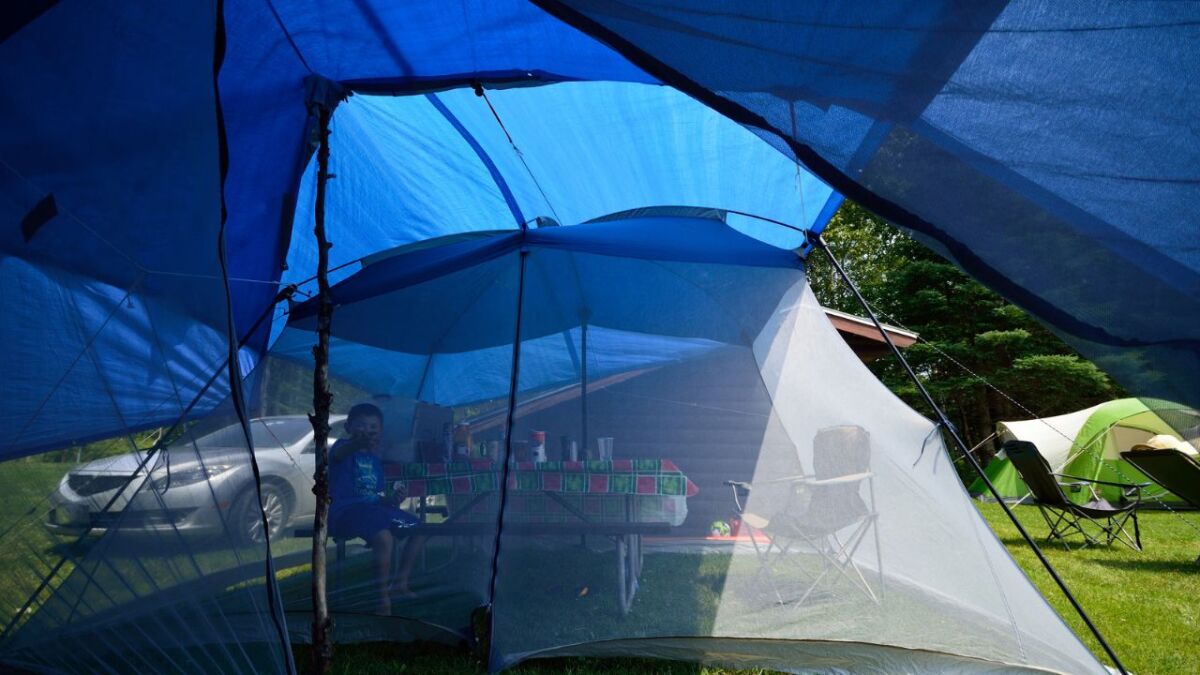
Simply set up next to the tent and secure it with ropes to a nearby tree or branch, forming an extension of the tent roof.
The corners of the tarp can be secured with pegs in the ground to ensure stability. This simple method expands the usable area of a tent and provides additional weather protection.
15. The Tarp as a Beach Mat
A tarp can also serve as a comfortable beach mat.
Thanks to its water-repellent properties, you stay dry and sand can be easily shaken off.
Simply lay the tarp flat on the sand and weigh down the corners with stones or sand to keep it in place. This provides a practical, durable, and versatile surface for relaxing hours at the beach.
To protect food from bears
A tarp can also be an effective method to store food safely, unreachable of bears.
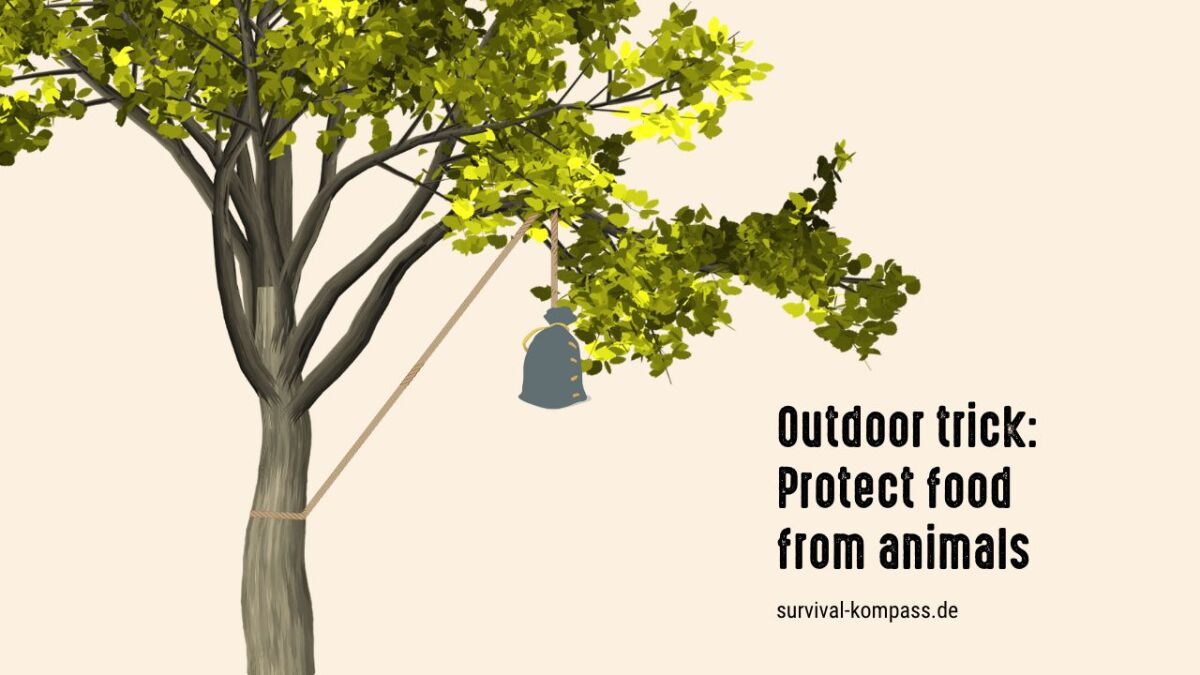
The tarp is used as a kind of bag in which the food is stored and then hung on a high branch.
With a rope thrown over the branch and attached to the tarp, the bag can be hoisted and kept safely unreachable of hungry bears.
This is a simple and effective way to safely store food while camping in bear areas.
17. Hideout for Wildlife Observation
Are you a photographer? Then your tarp can also serve as an effective hide for wildlife observation.
Simply stretched between two trees and placed at a height that provides a good view while remaining hidden.
With matching camouflage and strategically placed openings for observation, the tarp provides a discreet shelter that allows for observing nature in all its glory.
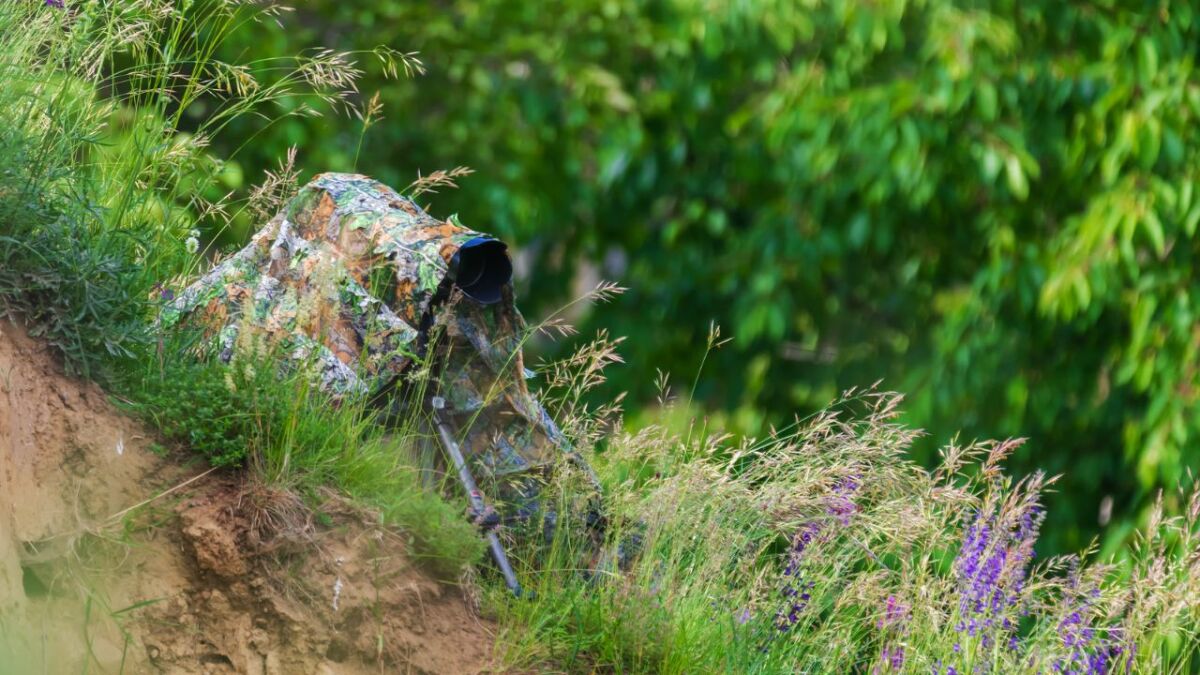
18. Waterproof Bag
When it rains again: A tarp can also function as a waterproof bag, ideal for keeping equipment dry.
- Simply spread out the tarp
- Place objects in the center
- Fold the corners together
- Secure with a rope
This creates an improvised waterproof bag that protects against the elements. It is a quick and easy solution to keep equipment dry in moist environments.
19. Sail for a Raft
Imagine relaxing on your self-built raft and gently drifting over the river or lake while the tarp sail does all the work for you.
Doesn't that sound like an unforgettable experience?
To use your tarp as a sail, you don't need much - just a little skill and the right technique.
- First, choose the corner of your tarp that is most exposed to the wind and tie it to a long pole or branch.
- Then, tie the other corners of the tarp to the corners of the raft with ropes or cords. Make sure the tarp is tightly stretched, so it can catch the wind well.
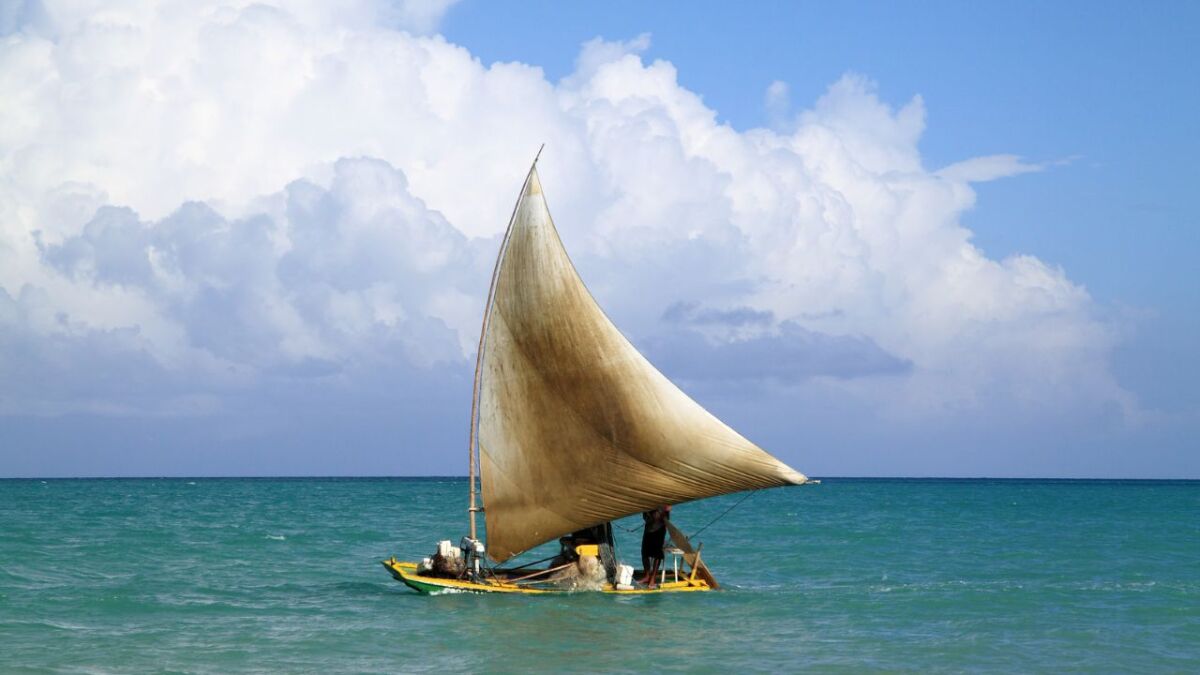
20. The Tarp as Snow Catcher / Snow Wall
The tarp as a snow wall provides you with effective protection against snowflakes and cold wind.
To use it as a snow wall, erect the tarp vertically next to your camp. Make sure it is placed in an optimal position to protect you from wind and falling snow.
Here are some tips:
- You need a solid structure to set up the tarp. Therefore, use stakes or sturdy branches to securely attach the corners and sides.
- Tighten the tarp so that the wind has no chance of blowing it away or snowing in it.
Thanks to this practical snow wall, you can sit comfortably in your camp and relax without constantly being surrounded by snowflakes. At the same time, the Tarp snow wall insulates your camp and keeps some warmth in your comfort zone.
21. Emergency Sleeping Bag
In an emergency, the familiar tarp can serve as an improvised sleeping bag.
By rolling or folding the tarp and getting inside, it can protect against cold and the elements.
Especially during sudden weather changes or unexpectedly cold nights, this simple trick can provide valuable warmth and make survival in the wilderness easier.
Such an emergency "sleeping bag" made of tarp is not a full replacement for good outdoor equipment, but can make a crucial difference in an emergency.
Tip: Stuff the interior with leaves as an insulation layer.
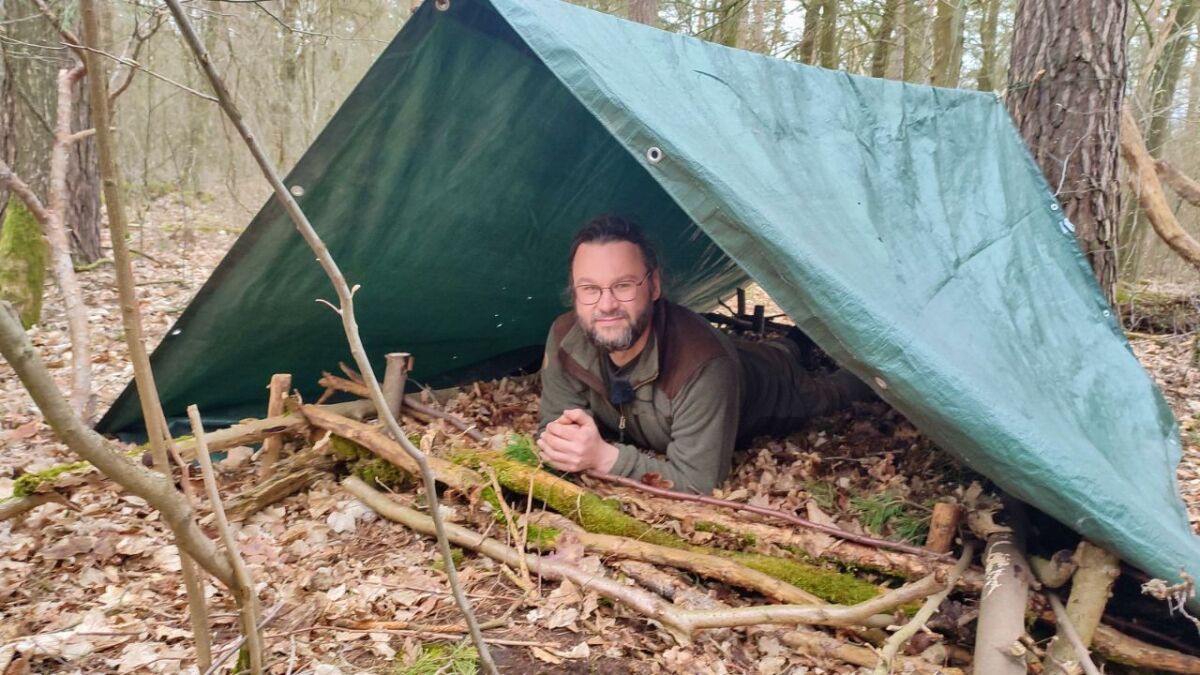
22. Cover for Firewood
Firewood needs protection from moisture and snow to burn efficiently.
Here comes the tarp into play, which serves as an ideal cover.
Stretch it over your stacked wood and secure it with stones or pegs to create a safe, dry storage.
Keep your firewood dry and ready for the next cozy campfire. This simple yet effective trick is a must for any outdoor enthusiast.
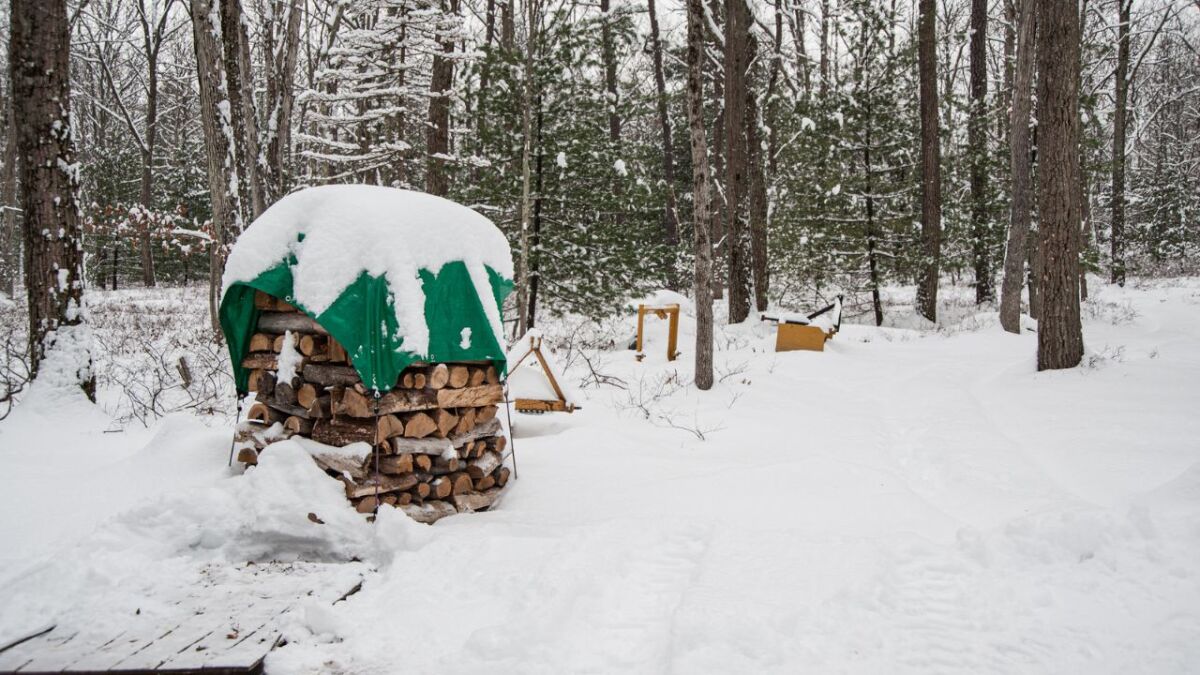
23. Plan for a Field Bed
A tarp can also serve as a comfortable field bed by being stretched between two sturdy branches attached to two tripods.
For this, the branches should be strong enough to support the weight of a person.
The tarp is then tightly stretched between the branches and securely fastened.
The construction should be stable enough to safely carry a person. Such a cot made from a tarp is a simple and effective way to create a sleeping place that protects against ground cold and small creatures.
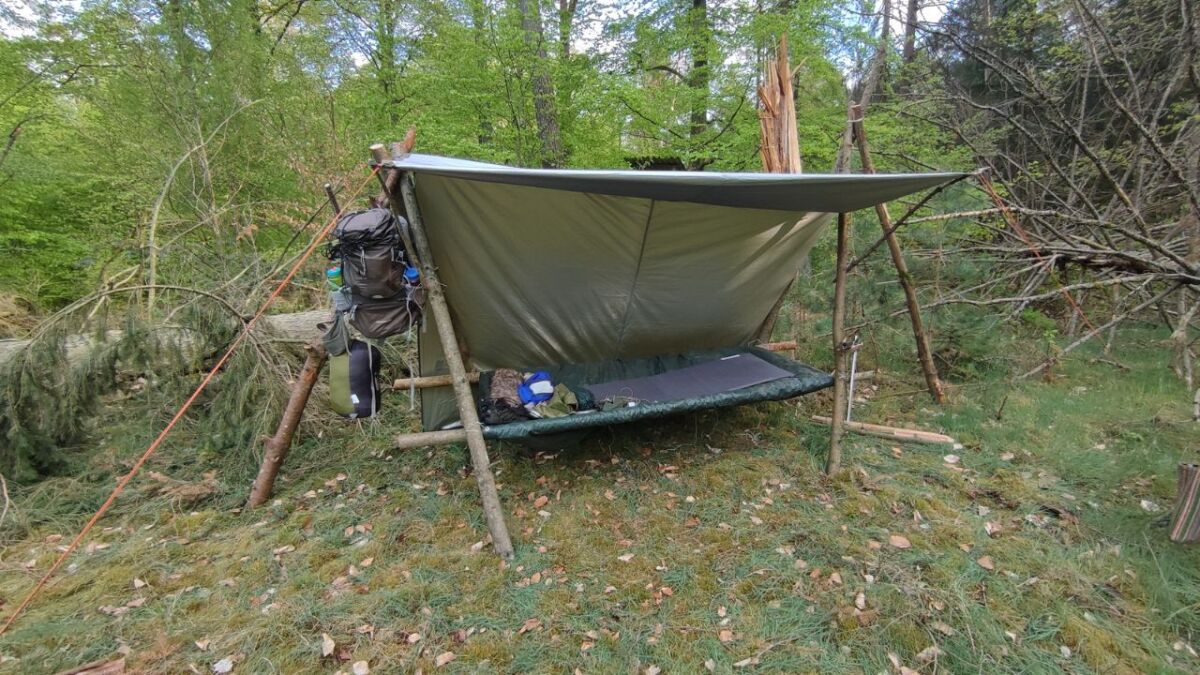
24. Seat cushion
Those who spend a lot of time outdoors know that a dry and comfortable seating option is often hard to come by. A tarp provides a quick solution.
Simply spread out, it serves as an excellent seat pad that protects against moisture, cold and uneven ground. This makes every outdoor excursion a little more pleasant.
25. Protection against dew and morning dew
If dew and morning dew spoil your camping experience, a tarp can be the perfect solution.
Stretched over the tent, it acts as an additional protective layer that prevents dew and morning dew from soaking your tent.
Attach it with ropes to surrounding trees or posts so that it forms a sloping roof over your tent. This way you can find a dry tent in the morning and start the day worry-free.
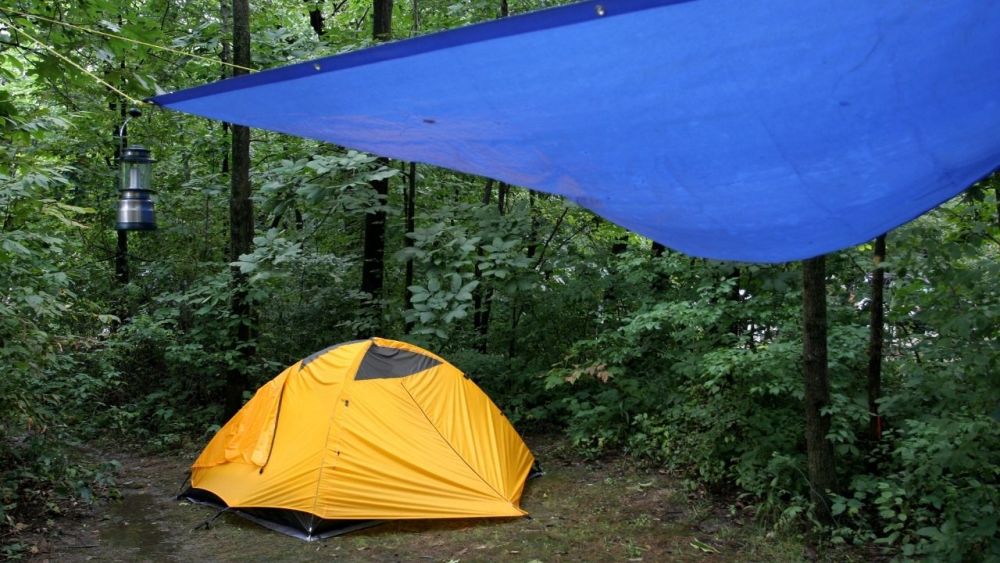
26. Protection against Sand and Dust
Sand and dust can be a real nuisance when you're outdoors. Here, a tarp can serve as a practical protection.
Simply laid out on the ground, it provides a clean and dry surface to sit, eat or place your equipment.
Keep sand and dust where they belong – under the tarp – and not in your food or equipment. An essential tip for desert tours or beach days.
Or, you can use the tarp as a windbreak during a sandstorm - keeping sand particles away from your equipment.
27. The tarp as a signal for rescue teams
In an emergency, a conspicuous tarp can be used as a signal for rescue teams. The bright or luminous material is easily visible from a distance.
In case of an emergency, it can be spread out and placed in an open area to attract the attention of passing airplanes or helicopters.
For maximum visibility, it should be placed at a high point, free from trees or bushes. This way, a tarp can become a crucial element in a rescue operation.
Also read
3 primitive signals to draw attention to yourself in an emergency - With signals, you make yourself noticeable in an emergency. Learn the three most important signals that you can create without modern aids.
28. Curtain or Room Divider in a Larger Tent
For additional privacy or simply to divide a larger space in a tent, a tarp can be ideal as a curtain or room divider.
It is simply hung between the tent poles or other suitable attachment points.
With some clips or ropes, it is possible to create a separate area or "room" within the tent.
Thus, the tarp serves as a flexible and easy way to organize an additional space in a tent.
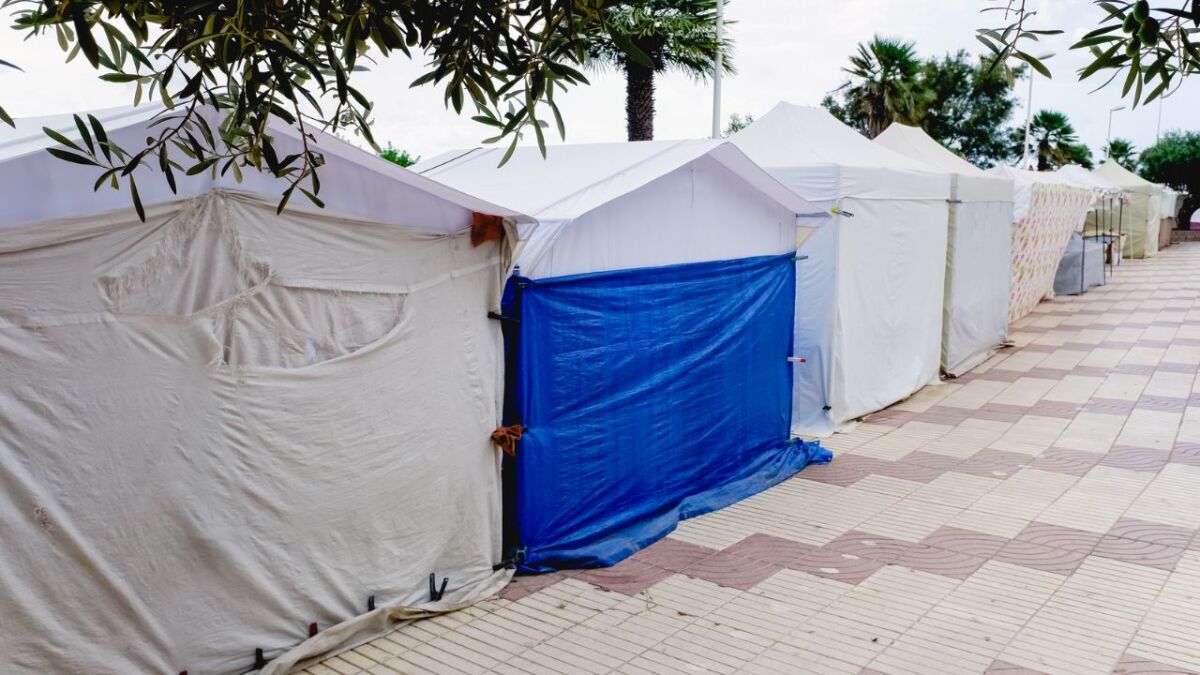
29. For covering, disassembling and pulling game
When you're out in the wilderness and need to break down the game, a tarp can be an incredibly useful tool.
It not only serves as a clean surface for disassembling the animal, but also as a practical means of transportation.
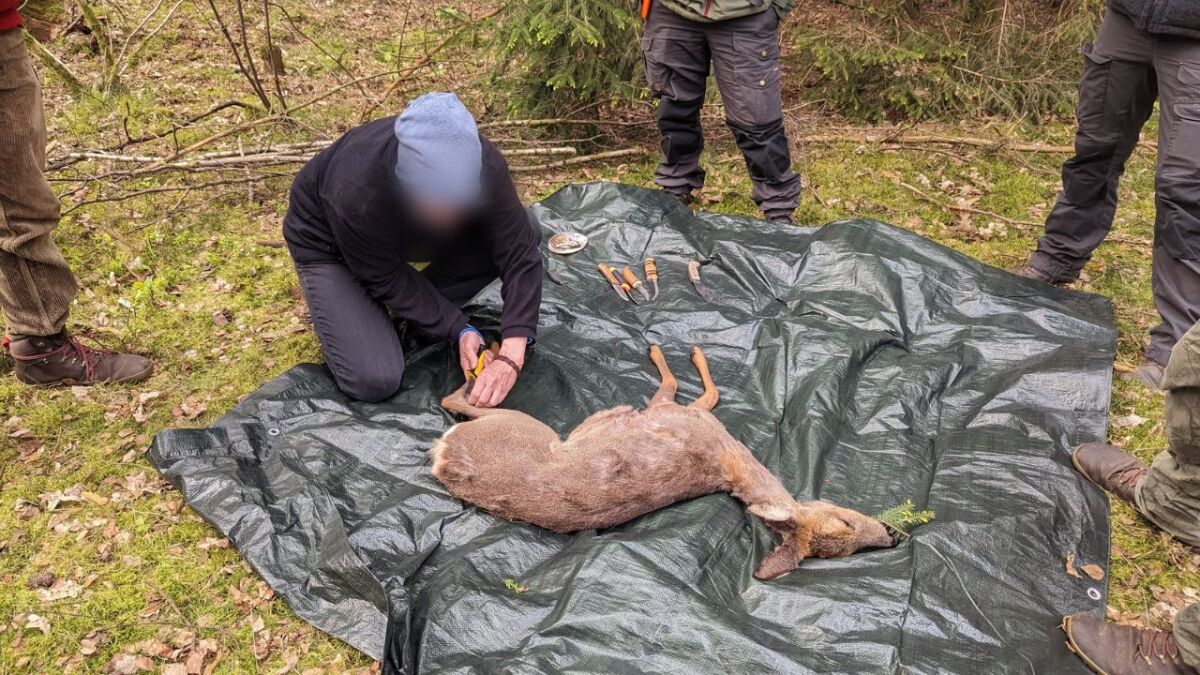
After disassembling, the meat can be wrapped in the tarp and protected from insects and dirt.
By attaching ropes to the ends of the tarp, the game can then be easily pulled through rough terrain.
This tarp trick is a valuable technique for hunters and outdoor enthusiasts.
30. A shower or a shower enclosure
With a little creativity and a tarp, you can also set up a temporary shower or shower compartment in the great outdoors.
Tie the corners of the tarp up to trees or poles to create a shelter.
Make sure that the tarp is hung high enough to have enough standing space and low enough to ensure privacy.
Within this "cabin", you can then hang a portable camping shower or even a simple water container. This way, the outdoor experience can be complemented with a touch of luxury and comfort.
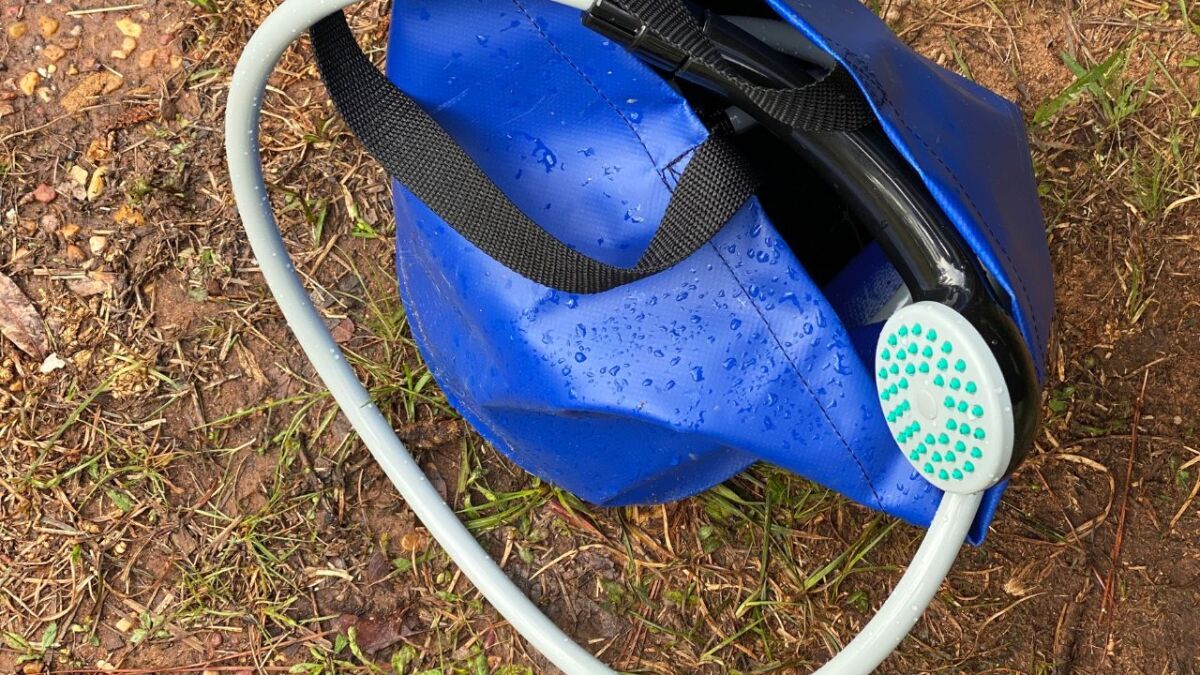
31. As a makeshift container
Occasionally, you need a container outside to collect or transport things.
And this is precisely where your tarp can come to the rescue.
By folding it into a kind of bowl and tying the ends tightly, you can create an improvised container.
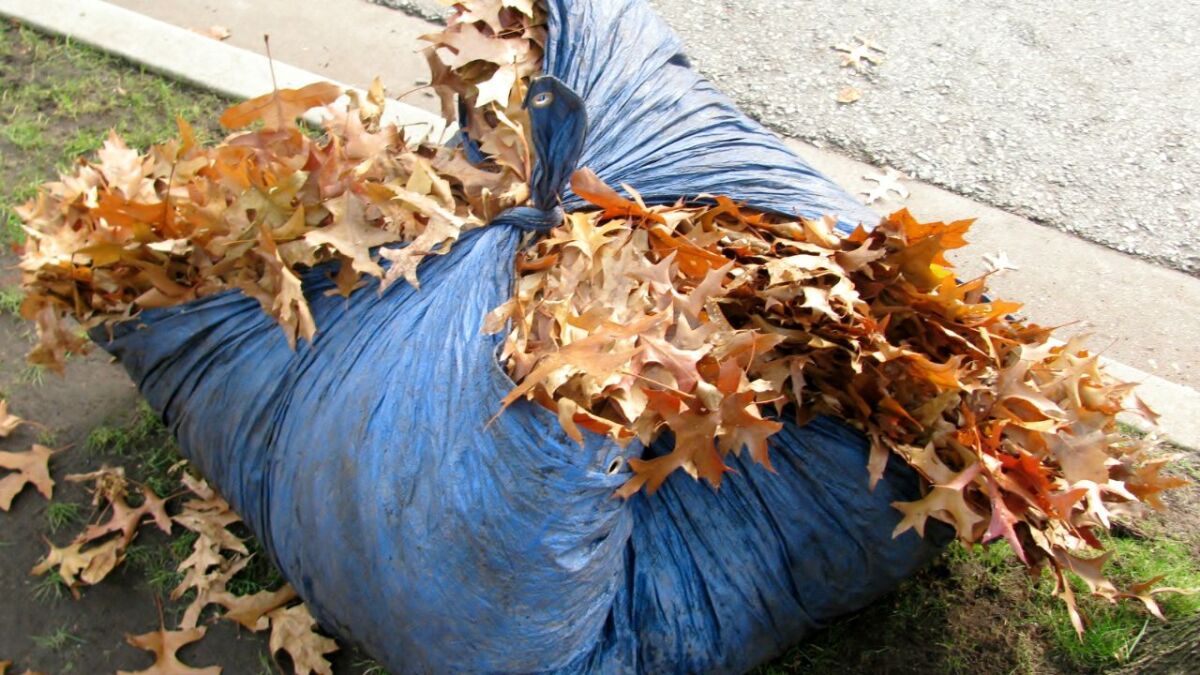
This is particularly practical for collecting water, transporting firewood, or even washing food.
A tarp as an emergency container is a clever and useful way to add more comfort to your outdoor adventure.
32. A Tarp as a Rope
Forgot or ran out of rope material?
No worries, the tarp can come to the rescue.
It can be easily converted into rope material. Simply cut the tarp into strips and twist them together.
The twisting provides stability and makes the resulting rope more resistant. This makes the tarp a practical solution when the actual rope material runs out and the tarp becomes more important.
Also read
7 common items that you can turn into ropes - You can make useful ropes from various materials under all circumstances. Let's take a closer look at 7 such materials that are suitable for ropes.
33. A Tarp as a Jacket
If the rain starts unexpectedly and there is no waterproof jacket at hand, a tarp can quickly be converted into a temporary rain jacket / poncho.
Put the tarp over your shoulders and head and secure it around your waist with a rope or belt.
If the tarp is large enough, sleeves can even be formed by wrapping the corners around the arms and tying them tightly.
This quick and easy solution protects against wetness and wind when the weather unexpectedly changes.
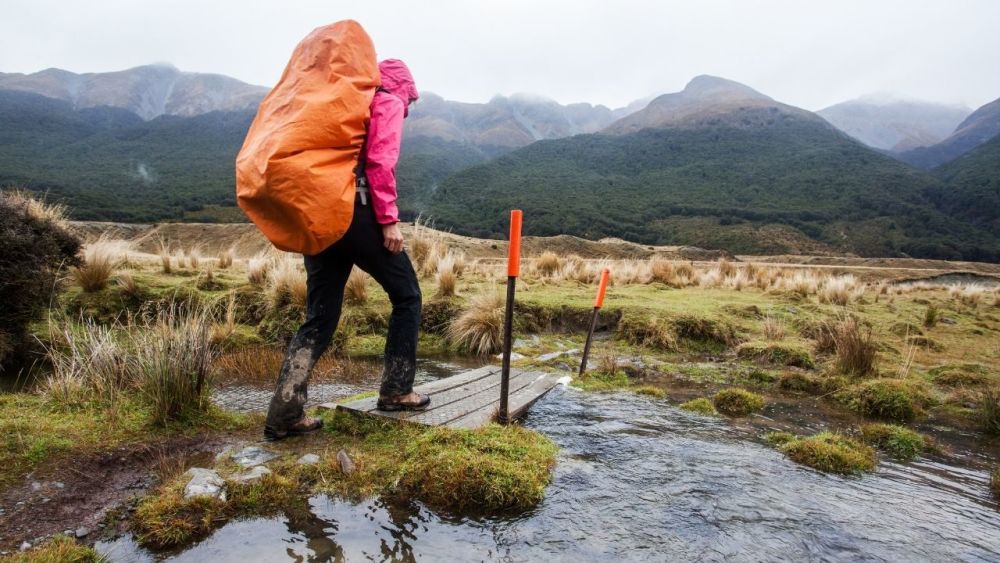
34. As provisional shoes
In an emergency where one is without suitable footwear, a tarp can provide a makeshift solution.
One can cut the tarp to size and wrap it around the feet to provide some protection against rough surfaces and moisture.
While they certainly do not provide the comfort and support of proper shoes, tarp shoes can help protect the feet from injuries and weather conditions in an emergency.
Ideally, you have string or duct tape in such a situation.
Also read
13 ways how duct tape can help you in emergencies - Duct tape is a valuable product, especially when you are in an emergency. Find here 13 ways that will definitely help you.
35. The Tarp as a Pillow
Who says you have to sacrifice comfort when you're out and about?
Even outdoors, the beloved tarp can serve as a comfortable pillow.
Simply roll or fold it until it reaches the desired thickness and softness, and your pillow is ready.
Whether on long hikes or while camping, this tarp head pillow is an unexpected luxury in the wilderness.
Conclusion: A tarp can be more versatile than it looks
The fact is: a tarp offers a variety of uses in the areas of camping, survival, and bushcraft.
It serves as a versatile tool that can be used in numerous situations, whether as protection against rain and wind, as emergency shelter for overnight stays, as sun protection or fire protection.
A tarp is easy to transport and can be quickly set up in various configurations to meet the requirements of the respective situation.
You can use it as an improvised tent or hammock, or use it as protection for equipment and supplies.
Setting up a tarp may require some knowledge and skills.
In my opinion, this applies particularly to the construction of emergency shelters.
When time is of the essence, every move should be perfect - that's something that needs to be learned! So prepare yourself for the various possibilities of use and practice, if you have the opportunity to do so.
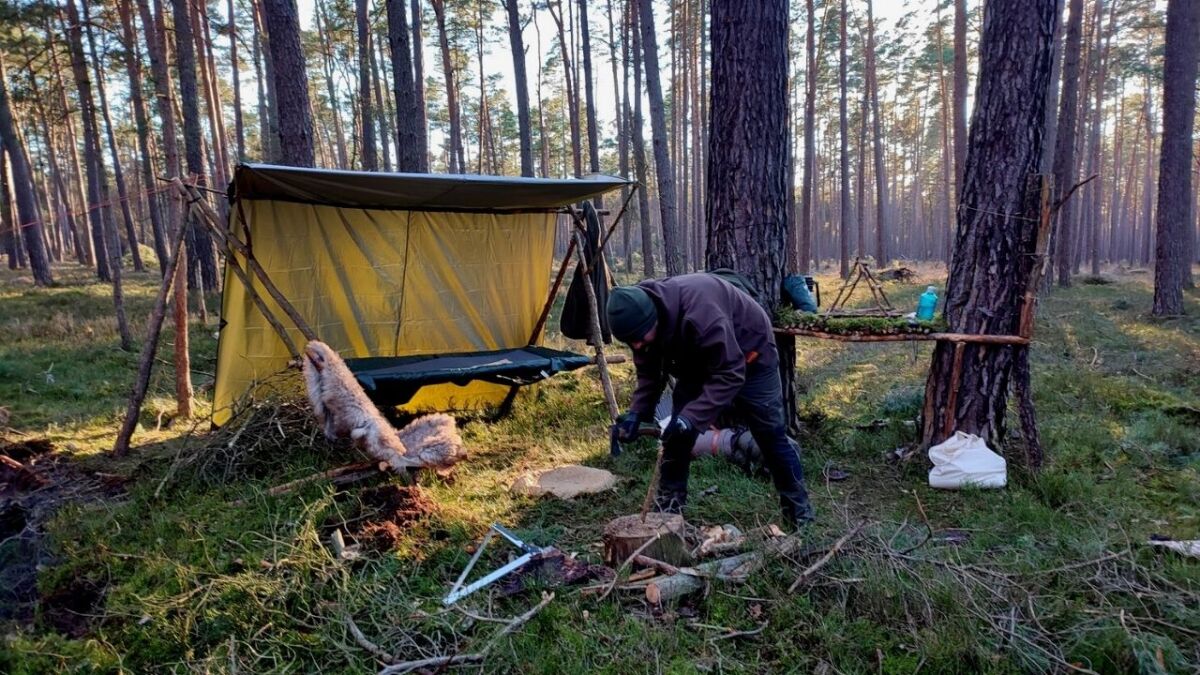
Overall, I see the tarp as an almost indispensable tool for you and all other survival and bushcraft enthusiasts, which can help to survive in the wilderness in the long term.
You increase your comfort and protect yourself in difficult situations. With all its possible uses, it belongs in the repertoire of every Bushcrafter or survival friend (Here is my equipment list).
I hope that I was able to provide you with added value through this article, and that you may have learned something new or were able to refresh and expand your existing knowledge.
I would be delighted if you took a look around my blog. Perhaps you will find more exciting articles that interest you.
You are welcome to leave a comment so that you can share your experiences. Maybe you have a great tip or an innovative method that could help others.


Author of the guide
Martin Gebhardt
Hey, I'm Martin. On my blog, you will learn the basics and numerous details about living in the wild. I think survival, bushcraft and the good life in nature are the keys to happiness. Find me here on Instagram or on YouTube. You can find more about my mission on the About Me page.
Was this guide helpful?
22 people found this guide helpful.
5.00 out of 5 points (22 Ratings)
Comments (0)
This post may contain affiliate links. So if you click on the links and make a purchase, I will receive a small commission at no additional cost to you. Click here, to learn more about it.


